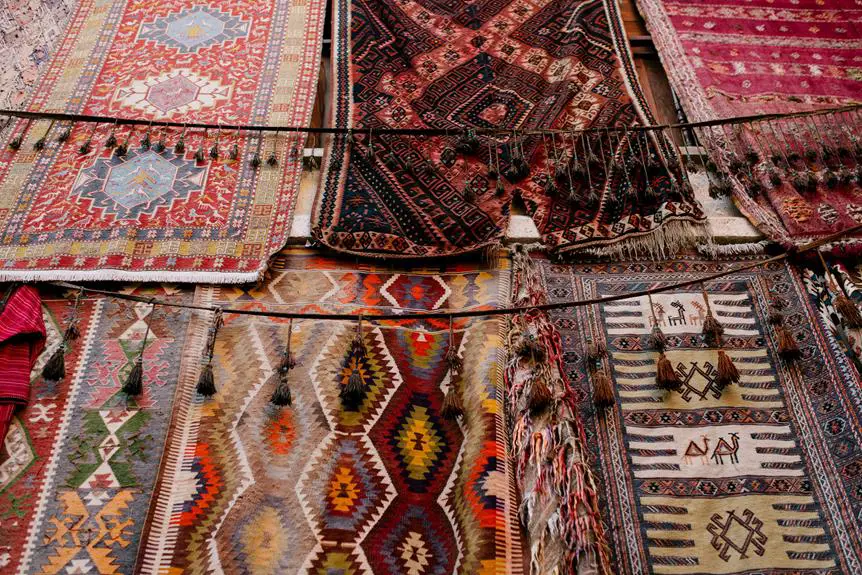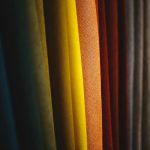You might not realize how taffeta fabric, with its origins in ancient Persia, has played a pivotal role in fashion history. Once a staple for nobility, it evolved through the Middle Ages and the Renaissance, reflecting wealth and status. Today, taffeta's sheen and structure continue to captivate designers and consumers alike. But what specific events and influences shaped its journey from a luxurious textile to a modern favorite? Understanding this evolution reveals much more than just fabric; it uncovers a tapestry of cultural significance that's worth exploring further.
Table of Contents
Origins of Taffeta
Tracing back its roots, taffeta originated in ancient Persia, where it was first woven from silk. This luxurious fabric quickly gained popularity due to its unique sheen and crisp texture. You might find it interesting that the word 'taffeta' comes from the Persian term 'taftah,' meaning “twisted” or “woven.” As trade routes expanded, taffeta made its way to Europe, captivating local artisans and fashion designers alike.
In the Middle Ages, taffeta became a staple in the wardrobes of the wealthy. Its lightweight and elegant qualities made it perfect for dresses, gowns, and even men's garments. You can imagine how its vibrant colors and patterns allowed the elite to showcase their status and taste. With its versatility, taffeta was also used for various decorative purposes, from draping in grand halls to creating elaborate costumes for theatrical performances.
As you explore the evolution of taffeta, you'll see how it transitioned through different eras, continually adapting to the changing tastes and technologies of fabric production. This adaptability has solidified taffeta's place in textile history, making it a fabric worth knowing about.
Taffeta in Ancient Cultures
When you think about taffeta in ancient cultures, you can't overlook its origins and the unique weaving techniques that shaped it.
This fabric didn't just serve practical purposes; it also held cultural significance that reflected the values and artistry of the times.
You'll discover how taffeta was woven into the fabric of society, influencing fashion and status across various civilizations.
Origins of Taffeta
Taffeta's origins can be traced back to ancient cultures, where its luxurious texture and sheen made it a favored fabric among royalty and the wealthy.
You'd find that its name derives from the Persian word 'taftah,' meaning 'twisted' or 'twisted cloth,' which hints at its intricate weaving process. Initially made from silk, taffeta was highly regarded in Persia and China, where artisans skillfully crafted it to showcase vibrant colors and a smooth finish.
As you explore its history, you'll notice that taffeta was often used in garments for the elite, from flowing robes to elegant gowns.
The fabric's ability to hold shape and resist creasing added to its appeal, making it perfect for formal attire. In ancient China, taffeta was even utilized for ceremonial purposes, highlighting its importance in various cultural practices.
Cultural Significance
In ancient cultures, taffeta symbolized luxury and status, often reserved for the garments of nobility and ceremonial attire. You'd find it adorning kings, queens, and high-ranking officials, showcasing their wealth and power. The fabric's smooth texture and shimmering finish made it a favorite for elaborate garments, elevating the wearer's appearance.
Taffeta's cultural significance extended beyond fashion. In many societies, it played a vital role in rituals and celebrations. For instance, during weddings or important festivals, taffeta garments signified the importance of the occasion, creating a visual spectacle that captured the attention of onlookers.
When you see taffeta in ancient art or artifacts, it reflects the values and aspirations of those who wore it. Moreover, the use of taffeta in cultural practices often denoted social hierarchy. The more intricate the taffeta garment, the higher the status of the wearer.
Ancient Weaving Techniques
The luxurious status of taffeta in ancient cultures was matched by the intricate weaving techniques that artisans employed to create this prized fabric. You'll find that these techniques varied significantly across regions, reflecting local resources and cultural practices.
In places like China, silk was spun and woven into taffeta using a systematic approach that emphasized fine threads and tight weaves, resulting in a smooth, lustrous finish.
In the Middle East, artisans utilized vertical looms, allowing them to create stunning geometric patterns and vibrant colors, which became hallmarks of their taffeta. The skill involved in manipulating the heddles and shuttles was passed down through generations, ensuring that the tradition remained alive.
You can appreciate that the labor-intensive process required not just technical expertise but also creativity, as each piece of taffeta told a story about its maker's culture.
The fusion of artistry and craftsmanship made taffeta not only a material of choice for garments but also a symbol of wealth and status.
Evolution During the Middle Ages
During the Middle Ages, taffeta frequently transformed from a luxury fabric reserved for the elite to a more accessible choice for various social classes. This shift occurred as advancements in weaving techniques and trade routes expanded, allowing more people to experience the beauty of taffeta.
You'd notice its vibrant colors and smooth texture becoming more commonplace in garments worn by merchants, artisans, and even some peasantry.
Here are three key factors that contributed to the evolution of taffeta during this period:
- Increased Production: The introduction of new looms and methods enabled more efficient fabric production, making taffeta available to a broader audience.
- Trade Expansion: The flourishing trade networks across Europe and Asia allowed for the import of various silk and fabric types, including taffeta, making it more affordable.
- Changing Fashion Trends: As social norms shifted, the demand for fashionable attire grew, leading to a wider variety of garments crafted from taffeta, from dresses to cloaks.
This evolution marked a significant turning point for taffeta, setting the stage for its future popularity in subsequent eras.
Renaissance and Taffeta's Popularity
During the Renaissance, taffeta emerged as a symbol of luxury, especially in Italian fashion.
You'll find it gracing the royal courts, where its shimmering texture became a staple for the elite.
As trade routes expanded, taffeta became more accessible, allowing even those outside the nobility to embrace its elegance.
Origins in Italy
Italy's Renaissance sparked a surge in taffeta's popularity, transforming it into a favored fabric for elegant garments and luxurious interiors. This period marked a significant shift in fashion, where vibrant colors and intricate designs became essential. As you explore the origins of taffeta, you'll notice how it captured the essence of Renaissance artistry and sophistication.
Here are three key factors that contributed to taffeta's rise during this time:
- Textile Innovation: The introduction of new weaving techniques allowed for finer textures and more elaborate patterns, making taffeta a desirable choice for both clothing and home decor.
- Cultural Exchange: Italy's position as a trade hub facilitated the exchange of fabrics and ideas, bringing taffeta from the East and inspiring local artisans to adopt and adapt its use.
- Wealth and Patronage: As the wealthy elite sought to showcase their status, taffeta became synonymous with luxury, often used in garments for celebrations, ceremonies, and public appearances.
With its shimmering qualities and versatility, taffeta became a staple in the wardrobes of the Renaissance, leaving an indelible mark on fashion history.
Royal Court Fashion
The opulence of royal court fashion during the Renaissance propelled taffeta into the spotlight, as nobles embraced its luxurious texture and vibrant hues to display their wealth and status.
You'd see taffeta adorning the gowns of queens and the attire of courtiers, transforming the court into a dazzling spectacle of color and elegance. This fabric's crispness and ability to hold intricate shapes made it perfect for the elaborate designs favored by the elite.
As you walked through the grand halls, you'd notice how the shimmering surface of taffeta caught the light, enhancing the richness of jeweled embroidery and embellishments. It wasn't just about beauty; it was a statement of power.
Wearing taffeta meant you were part of an exclusive club, a visual representation of your rank in society. Tailors and seamstresses worked tirelessly to create garments that showcased the fluidity and movement of taffeta, making every turn and gesture captivating.
The fabric's popularity soared, influencing not just the fashion of the time but also the way people perceived their social standing. In the royal courts, taffeta was more than a fabric; it was a symbol of an era marked by extravagance and artistry.
Trade and Accessibility
Taffeta's rise in popularity during the Renaissance was fueled by burgeoning trade routes that made this luxurious fabric more accessible to the wealthy elite across Europe. As merchants expanded their networks, they introduced taffeta to various courts, creating a demand for this shimmering textile. You'd find it in the wardrobes of nobility, where its crisp texture and vibrant colors became the epitome of elegance.
The fabric's popularity can be attributed to several key factors:
- Increased Trade: With the opening of new trade routes, silk from the East flowed into Europe, allowing for larger quantities of taffeta to be produced and sold.
- Technological Advancements: Innovations in weaving techniques enabled artisans to create more intricate patterns and vibrant dyes, enhancing the allure of taffeta.
- Cultural Exchange: The Renaissance was a time of cultural flourishing, where ideas and fashions mingled, further promoting taffeta in various styles across countries.
You can see how taffeta became a symbol of status, reflecting not just wealth but also the interconnectedness of European society during this transformative era.
Taffeta in the 19th Century
During the 19th century, fashion houses embraced taffeta for its crisp texture and elegant sheen, making it a favorite choice for evening gowns and formal wear.
You'd notice that this fabric was often used in the creation of ball gowns, where its ability to hold shape added volume and drama to the skirts. Designers loved how taffeta could be easily manipulated into intricate pleats and ruffles, enhancing the overall silhouette.
In addition to evening wear, taffeta found its way into day dresses and accessories. Women of the time appreciated its versatility, allowing them to mix and match fabrics for various occasions. As taffeta became more accessible, you'd see it pop up in both high fashion and everyday wear, reflecting changing societal norms.
The vibrant colors and patterns available in taffeta also captured the spirit of the era, with fashion trends shifting rapidly. With its luxurious appearance, taffeta became synonymous with elegance, making it a staple in many wardrobes.
The 19th century truly showcased taffeta as a fabric that defined sophistication and style, setting the stage for its continued popularity in the years to come.
Modern Uses of Taffeta
Today, many designers turn to taffeta for its unique blend of structure and elegance, making it a popular choice for formal wear and special events. You'll find taffeta in a variety of garments that accentuate its crisp texture and ability to hold shapes, providing a stunning visual appeal.
Here are some modern uses of taffeta:
- Evening Gowns: Taffeta's luxurious sheen and stiffness make it a favored fabric for evening gowns, giving them a dramatic flair that stands out on the red carpet or at weddings.
- Bridal Dresses: Many brides choose taffeta for their wedding dresses due to its ability to create voluminous skirts and intricate designs, ensuring they look breathtaking on their special day.
- Home Décor: Taffeta isn't limited to clothing; it's also used in home décor, such as curtains and table settings, where its elegant appearance adds a touch of sophistication to any space.
In these applications, taffeta continues to be a versatile and stylish choice, enhancing both fashion and interiors with its distinctive qualities.
Taffeta's Impact on Fashion Today
Many designers embrace taffeta for its ability to elevate contemporary fashion, infusing garments with a striking blend of elegance and structure. You'll notice it often gracing the runways, where its crisp texture and unique sheen create eye-catching silhouettes. Taffeta's versatility makes it a favorite for both evening wear and special occasions, adding a touch of sophistication that's hard to replicate with other fabrics.
When you wear taffeta, you experience a sense of luxury that enhances any outfit. It's particularly popular in ball gowns and wedding dresses, where its ability to hold shape contributes to a dramatic flair. Designers like Oscar de la Renta and Carolina Herrera skillfully incorporate taffeta into their collections, showcasing its timeless appeal.
Additionally, taffeta isn't just reserved for formal attire; you'll find it in casual styles too, from chic blouses to stylish skirts. Its adaptability means you can easily integrate it into your wardrobe, whether you're dressing up or down.
As you explore today's fashion landscape, keep an eye out for taffeta—it's a fabric that continues to make a significant impact, blending tradition with modern aesthetics.
Frequently Asked Questions
What Are the Different Types of Taffeta Fabrics Available Today?
You'll find various types of taffeta today, including silk taffeta, polyester taffeta, and nylon taffeta. Each type offers unique textures and finishes, making them suitable for different fashion and home decor applications.
How Should Taffeta Be Cared for and Cleaned?
To care for taffeta, hand wash it in cold water with mild detergent, avoid wringing, and hang to dry. If ironing's needed, use a low heat setting and place a cloth between the iron and fabric.
Is Taffeta Suitable for All Seasons?
Taffeta isn't suitable for all seasons. It's lightweight and crisp, making it great for spring and summer, but its lack of breathability can make you uncomfortable in hot weather or during humid conditions.
Can Taffeta Be Recycled or Is It Biodegradable?
Taffeta isn't biodegradable, but some types can be recycled. You should check local recycling guidelines to see if they accept it, as many facilities may not recycle synthetic fabrics like taffeta.
What Are Common Uses for Taffeta Outside of Fashion?
You'll find taffeta used in various applications beyond fashion, like home décor, draperies, tablecloths, and upholstery. It's also popular for event decorations, such as balloons and backdrops, thanks to its crisp texture and elegant appearance.
- Does Kevlar Fabric Stretch? Flexibility and Its Limitations - June 21, 2025
- Kevlar Fabric and Fabric Sprays: Debunking Myths About Vulnerability - June 21, 2025
- Can a Dog Tear Kevlar Fabric? Understanding Its Strength - June 21, 2025







